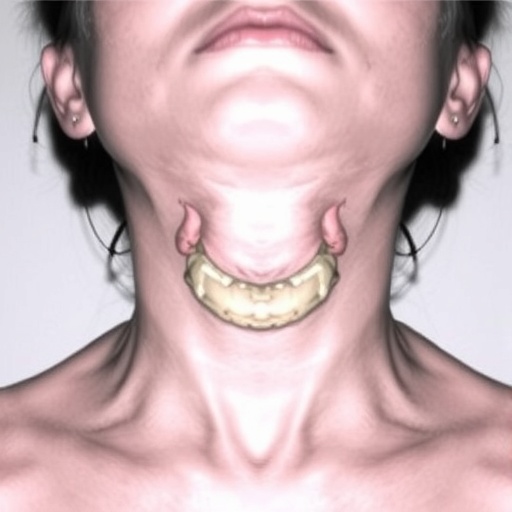Recent advances in medical research have unveiled a rare but significant condition known as thyroid hemiagenesis, a developmental anomaly characterized by the absence of one lobe of the thyroid gland. In a recent case reported by researchers G.J. Bedada, S.K. Adugna, and A.G. Bone, the clinical implications of right thyroid hemiagenesis were explored, particularly when associated with a contralateral simple diffuse goiter. This finding adds a new dimension to our understanding of thyroid pathology and offers potential insights into management strategies for conditions involving thyroid volume and function.
The human thyroid gland, a vital endocrine organ located in the cervical region, is responsible for producing hormones that regulate metabolism, growth, and development. Its normal anatomy consists of two lobes connected by an isthmus, and any variation in its structure can lead to significant physiological consequences. In this case, the right lobe was found to be absent, while the left lobe presented with a simple diffuse goiter, highlighting the complex interplay between the absence of one thyroid lobe and compensatory mechanisms in the remaining lobe.
Thyroid hemiagenesis is an intriguing condition, often discovered incidentally during imaging studies or evaluations for other thyroid-related disorders. Clinicians and surgeons must be aware of this possibility, especially when faced with patients exhibiting goiter or other thyroid abnormalities. The case presented by Bedada and colleagues provides critical insight into not only the occurrence of this anomaly but also the potential manifestations it can trigger, urging healthcare providers to adopt a thorough approach toward diagnosis and treatment.
In their case report, the authors noted that the patient, initially presenting with symptoms typically associated with hypothyroidism, underwent imaging studies that revealed the absence of the right thyroid lobe. Interestingly, the left lobe appeared enlarged, suggesting a compensatory response due to the loss of the right lobe. It raises questions about how the remaining functional tissue adapts to the payload of hormone production and how this may influence clinical presentation and patient management.
The clinical significance of such anatomical variations cannot be understated. For instance, the development of a contralateral simple diffuse goiter in the presence of hemiagenesis indicates a possible compensatory increase in hormone production, which may ultimately confound clinical diagnosis. Understanding the underlying mechanisms driving these adaptations is crucial for healthcare professionals managing patients with thyroid disorders that diverge from the typical anatomical and functional frameworks.
The methodology used to arrive at the diagnosis encapsulated in the case report reflects a comprehensive approach, including laboratory assessments that analyzed serum hormone levels and imaging modalities such as ultrasound. These evaluations not only confirmed the suspected diagnosis of right thyroid hemiagenesis but also provided a deeper understanding of the patient’s hormonal profile, which is crucial for tailoring a management plan.
Furthermore, the case explores management options for patients diagnosed with such anomalies. Given the rarity of right thyroid hemiagenesis, treatment protocols often rely on clinical judgment and individual patient factors. The authors commented on the necessity of a personalized approach, particularly when addressing the goiter or symptoms arising from hormonal imbalance. Options may include monitoring, hormonal supplementation, or in some cases, surgical intervention, depending on the extent of symptoms and the presence of other complications.
In this unique scenario, it is essential for researchers and clinicians alike to share insights and outcomes through formal avenues such as case reports, which can guide future studies and refine clinical approaches. This case stands as a testament to the complexity of thyroid pathologies and the need for continuous research to understand rare conditions profoundly.
The pathophysiological mechanisms underlying thyroid development and abnormalities remain an area ripe for exploration. Investigating how the thyroid gland compensates for structural deficiencies can unravel the delicate balance between glandular anatomy and hormonal output. This research can also direct attention to genetic and environmental factors that may contribute to the occurrence of thyroid anomalies, paving the way for prospective studies focusing on the incidence and management strategies of cases like this one.
Moreover, this case report highlights the importance of interdisciplinary collaborations in the field of endocrinology, surgery, and radiology. Effective management of thyroid conditions often necessitates a team approach, integrating the insights of various specialists to achieve optimal patient outcomes. Future research initiatives should prioritize establishing guidelines for managing rare thyroid disorders, fostering a network of clinicians keen on sharing findings and improving patient care across diverse medical settings.
In closing, the account of right thyroid hemiagenesis accompanied by a contralateral simple diffuse goiter underscores a vital aspect of endocrine health. By dissecting the nuances of such rare endocrine disorders, researchers inform and shape clinical understanding and management policies that could significantly enhance patient care. The call for continued research and discussion surrounding these unique cases cannot be overstated, as they enrich the tapestry of medical knowledge and practice.
In conclusion, the contribution of this case report to the existing literature on thyroid anomalies is significant. It not only enhances our understanding of thyroid development and adaptation but also underscores the importance of a meticulous approach in diagnosing and managing endocrine diseases. As we delve deeper into the complexities of thyroid physiology and pathology, it becomes increasingly clear that each case holds the potential to reveal broader insights that could benefit numerous patients in the future.
Subject of Research: Right thyroid hemiagenesis and contralateral simple diffuse goiter
Article Title: Right thyroid hemiagenesis presenting with a contralateral simple diffuse goiter: case report.
Article References:
Bedada, G.J., Adugna, S.K., Bone, A.G. et al. Right thyroid hemiagenesis presenting with a contralateral simple diffuse goiter: case report.
BMC Endocr Disord 25, 227 (2025). https://doi.org/10.1186/s12902-025-02047-3
Image Credits: AI Generated
DOI: 10.1186/s12902-025-02047-3
Keywords: thyroid hemiagenesis, diffuse goiter, thyroid pathology, endocrine health, case report




